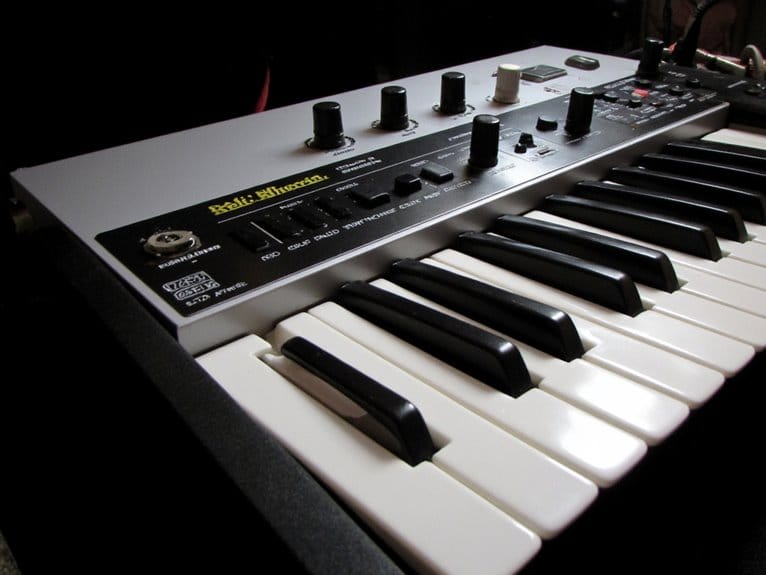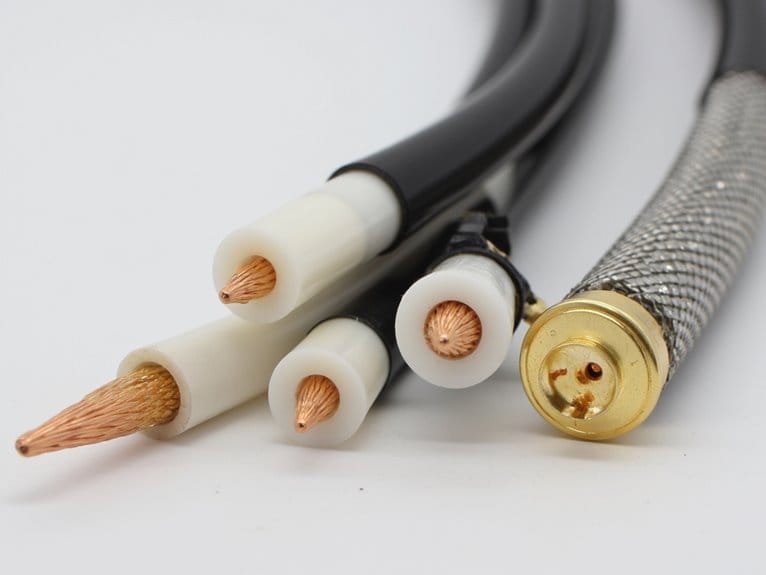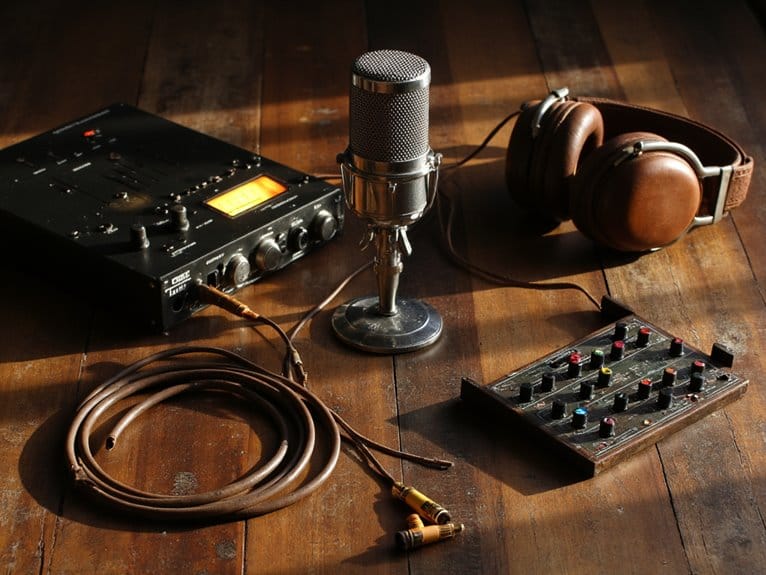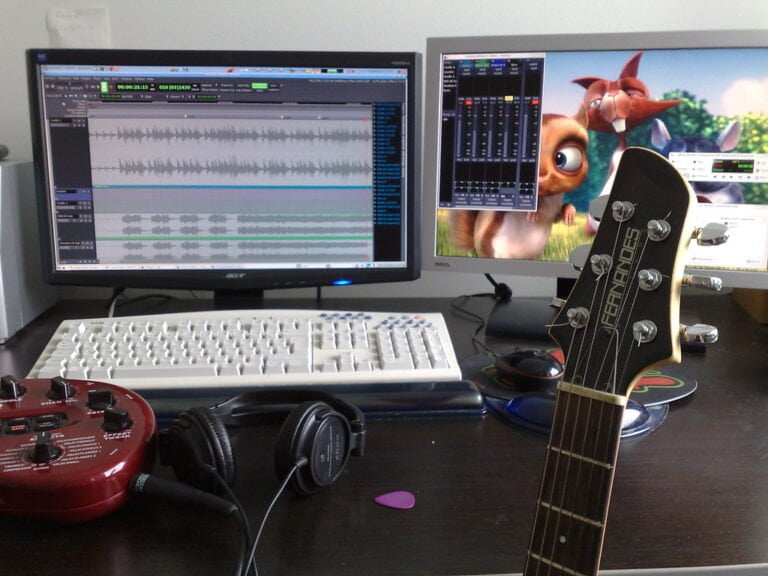Understanding Synthesizer Polyphony Vs Monophony
When you’re selecting a synthesizer, monophonic models produce only one note at a time through a single signal path, creating that characteristic “fat” sound perfect for bass lines and lead melodies, while polyphonic synths handle multiple simultaneous notes using independent voice circuits, allowing you to play chords and complex harmonies. Monophonic synths excel at aggressive filter sweeps and portamento effects, whereas polyphonic models shine in ambient textures and chordal work, though individual voices may sound thinner due to shared resources—and there’s much more to examine about voice allocation, notable models, and how these architectural differences impact your creative decisions.
We are supported by our audience. When you purchase through links on our site, we may earn an affiliate commission, at no extra cost for you. Learn more.
Notable Insights
- Monophonic synthesizers produce only one note at a time, making them ideal for bass lines and lead melodies.
- Polyphonic synthesizers can play multiple simultaneous notes, enabling chords and complex harmonies in musical compositions.
- Monophonic synths deliver a “fat” sound through focused signal paths, while polyphonic voices may sound thinner.
- Polyphonic synths require independent signal paths for each voice, including separate oscillators and filters per note.
- Budget synthesizers typically offer four to eight-note polyphony to balance functionality with cost-effective manufacturing.
What Makes a Synthesizer Monophonic or Polyphonic
When I first started exploring synthesizers, I’ll admit the whole monophonic versus polyphonic thing confused me more than it should have, but the distinction really comes down to a simple concept: how many notes your synth can produce at once.
A monophonic synthesizer, regardless of its internal oscillator count or other synthesizer features, produces only one note at a time, making it perfect for bass lines and lead melodies.
When you press multiple keys, only the last one you hit will sound, cutting off previous notes—that’s the key functionality that defines monophony. This behavior is called last note priority, where the earliest played note is cut off when a new one is triggered.
Polyphonic synths, on the other hand, can handle multiple simultaneous notes, enabling you to play chords and complex harmonies that would be impossible on their monophonic counterparts. The term polyphony literally derives from the Greek language, where poly means many and phony refers to voice.
Technical Architecture and Voice Management Systems
Behind the scenes of every synthesizer lies a complex architecture that determines whether you’ll be playing single notes or full chords, and I’ve found that understanding these technical foundations really helps explain why some synths cost considerably more than others. True polyphony requires duplicating entire signal paths for each voice, which means separate oscillators, filters, and amplifiers per note. Voice allocation systems manage this complexity through sophisticated control voltage distribution.
| Architecture | Signal Path | Voice Management |
|---|---|---|
| Monophonic | Single shared path | One CV/gate signal |
| Paraphonic | Shared filter/amp | Limited allocation |
| Polyphonic | Independent per voice | Complex stealing algorithms |
Early analog synths struggled with these hardware demands, making polyphony expensive and technically challenging, while modern digital implementations handle voice allocation through software rather than physical circuit duplication. Most budget synthesizers under $500 typically offer four to eight-note polyphony, which provides a practical balance between functionality and cost constraints. The marketing terminology used to describe these different architectures often diverges from academic definitions, creating confusion about what constitutes true polyphony versus other forms of multiple note playback.
Musical Applications and Performance Contexts
The real magic of understanding polyphony versus monophony becomes apparent when you’re actually making music, and I’ve discovered that choosing the right synthesizer type can make or break your performance depending on what you’re trying to achieve.
In live performance, you’ll find monophonic synts excel at cutting through dense mixes with focused lead lines, while polyphonic instruments handle the harmonic heavy lifting that audiences expect.
Studio composition opens different possibilities entirely, where you can layer monophonic parts for complexity or rely on polyphonic synths for rich, textural foundations. The Roland Tweak Synth (S-1) exemplifies this versatility with its four-voice polyphony supporting mono, poly, unison, and chord modes for different creative applications.
- Monophonic synths shine in genres emphasizing melody and solos, particularly classic synth-pop and electronic music.
- Polyphonic instruments dominate ambient, progressive rock, and modern pop productions requiring chordal support.
- Performance techniques vary dramatically, with monophonic synths supporting expressive portamento while polyphonic models enable intricate voicings. For producers seeking maximum harmonic complexity, the Roland SH-4d offers 60 voices of polyphony to support the most demanding chord structures and layered arrangements.
Modern digital synthesizers like the Arturia MiniFreak offer six-voice polyphony that bridges the gap between simple chord progressions and complex harmonic arrangements.
Sound Design Trade-offs and Sonic Characteristics
While musical applications reveal the practical differences between mono and polyphonic synths, the sonic characteristics and sound design trade-offs represent where these instruments truly diverge in their fundamental DNA. I’ve found that understanding these distinctions helps you make smarter decisions about which tool fits your creative vision.
Monophonic synths deliver that legendary “fat” sound through focused signal paths, creating cutting leads and basslines that slice through dense mixes.
You’ll notice their simpler architecture allows for incredible expressiveness factors like nuanced portamento and aggressive filter sweeps that define each note’s character.
Polyphonic synths excel at sound layering, generating lush pads and evolving atmospheric textures through multiple simultaneous voices, though individual voices may sound thinner compared to their monophonic counterparts due to shared resources.
Notable Models and Historical Development
When you trace synthesizer history back to its roots, every single early model was monophonic by necessity, not choice, because the analog circuitry required to generate multiple simultaneous voices was prohibitively complex and expensive for manufacturers in the 1960s and early 1970s. The Moog Model D exemplified this era, delivering rich analog tones but limiting you to single notes.
Synthesizer evolution accelerated dramatically when key innovations in circuit design enabled true polyphony.
- Sequential Circuits Prophet-5, Oberheim OB-8, and Roland Jupiter-8 became the gold standard for analog polyphonic synthesizers in the late 1970s
- Virtual-analog models like the Clavia Nord Lead revolutionized polyphony by using digital processors to emulate analog warmth
- Modern recreations, including Behringer’s Pro-800, make classic polyphonic designs accessible to contemporary musicians
Frequently Asked Questions
Can I Convert a Monophonic Synthesizer to Polyphonic Using External Hardware?
You can’t truly convert monophonic synthesizers to polyphonic using external hardware alone. While monophonic adapters and external modules can layer multiple voices, they don’t transform your synth’s single-voice architecture into genuine polyphony.
Can You Play Polyphonic Synthesizers Through Multiple Outputs Simultaneously?
You can play polyphonic synthesizers through multiple outputs simultaneously if they have multi output capabilities. This depends on the synthesizer audio routing design, with professional and modular synths commonly offering separate voice or engine outputs.
On a final note
You’ve now explored how polyphony and monophony fundamentally shape your synthesizer experience, from the underlying voice allocation circuits that determine simultaneous note capacity to the distinct sonic characteristics each approach delivers. Whether you’re drawn to the focused intensity of monophonic leads or the harmonic complexity of polyphonic textures, understanding these architectural differences will guide your instrument choices and open new creative possibilities in your musical journey.







